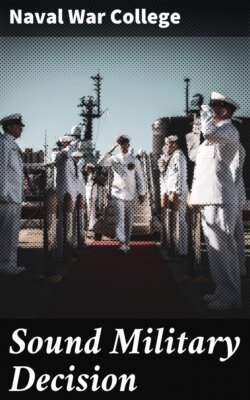Sound Military Decision

Реклама. ООО «ЛитРес», ИНН: 7719571260.
Оглавление
Naval War College. Sound Military Decision
Sound Military Decision
Table of Contents
Newport, Rhode Island
(See Chart on page XXXX)
FOREWORDToC
PART I. PROFESSIONAL JUDGMENT IN ITS RELATION TO. THE SUCCESSFUL CONDUCT OF WAR
CHAPTER IToC
COMMAND AND ITS PROBLEMS
CHAPTER IIToC
CHAPTER IIIToC
BASIC PRINCIPLES APPLICABLE TO MILITARY PROBLEMS (The Fundamental Military Principle)
The Fundamental Military Principle
CHAPTER IVToC
THE APPLICATION OF THE FUNDAMENTAL MILITARY PRINCIPLE (Objectives—Their Selection and Attainment)
I. MAJOR COMPONENTS OF MILITARY PROBLEMS
II. SELECTION OF CORRECT MILITARY OBJECTIVES
III. DETERMINATION OF EFFECTIVE MILITARY OPERATIONS
Physical Objectives
Relative Positions
Apportionment of Fighting Strength
Freedom of Action
IV. SUMMARY
CHAPTER VToC
FOUR STEPS IN THE SOLUTION OF A MILITARY PROBLEM
The Approach to the Solution
The First Step
The Second Step
The Third Step
The Fourth Step
Sequence of Events in the Four Steps
The Use of a Form in the Solution of Problems
Conclusion As To the Approach to the Solution of Military Problems
PART II. THE EXERCISE OF PROFESSIONAL JUDGMENT. IN PLANNING
CHAPTER VIToC
SECTION I. ESTABLISHMENT OF THE BASIS FOR SOLUTION OF THE PROBLEM
A. The Appropriate Effect Desired
B. Relative Fighting Strength
(1) Survey of the Means Available and Opposed
(2) Survey of the Characteristics of the Theater of Operations
(3) Conclusions as to Relative Fighting Strength
NOTE
SECTION II. DETERMINATION OF SUITABLE, FEASIBLE, AND ACCEPTABLE COURSES OF ACTION. A. Analysis of the Assigned Objective
B. Survey of Courses of Action
C. Application of Tests for Suitability, Feasibility, and Acceptability
D. Listing Retained Courses of Action
SECTION III. EXAMINATION INTO THE CAPABILITIES OF THE ENEMY
A. Survey of the Enemy's Problem
(1) Summary of the Enemy's Situation
(2) Analysis of the Effect Desired by the Enemy
B. Survey of Enemy Capabilities
C. Application of Tests for Suitability, Feasibility, and Acceptability
D. Listing Retained Enemy Courses of Action
SECTION IV. SELECTION OF THE BEST COURSE OF ACTION
A. Analysis and Comparison of Retained Courses of Action
B. Determination of the Best Course of Action
SECTION V. THE DECISION
CHAPTER VIIToC
THE RESOLUTION OF THE REQUIRED ACTION INTO DETAILED OPERATIONS (The Second Step—The Solution of Subsidiary Problems)
Application of the Essential Elements of a Favorable Military Operation
Testing for Suitability, Feasibility, and Acceptability
The Formulation of Tasks
The Organization of Task Forces and Task Groups
Application of the Fundamental Military Principle to the Determination of Objectives Embodied in Tasks
The Assembly of Measures for Freedom of Action
The Preparation of Subsidiary Plans
PART III. THE EXERCISE OF PROFESSIONAL JUDGMENT. IN THE EXECUTION OF THE PLAN
CHAPTER VIIIToC
THE INAUGURATION OF THE PLANNED ACTION (The Third Step—The Formulation and Issue of Directives)
Essentials of Military Directives
Restatement of the Decision for Use in the Directive
Standard Forms for Plans and Directives
Types of Naval Directives
CHAPTER IXToC
THE SUPERVISION OF THE PLANNED ACTION (The Fourth Step)
Problems Involving Modifications of the Basic Plan
Problems Challenging the Integrity of the Basic Plan
The Further Procedure Applicable to Such Problems of The Fourth Step
The Running Estimate of the Situation
JOURNAL
WORK SHEET (For Running Estimate of the Situation)
Special Remarks as to Entries
Summary
CONCLUSIONToC
OUTLINE FORM OF AN OPERATION PLAN
TABULAR FORMSToC
TABULAR FORM OF. THE ESTIMATE OF THE SITUATION
TABULAR FORM OF. THE RESOLUTION OF THE REQUIRED ACTION. INTO DETAILED OPERATIONS
INDEX
INDEXToC
Отрывок из книги
Naval War College
Published by Good Press, 2019
.....
Military Strategy and Tactics. Military strategy as distinguished by objectives (page 3) representing a larger, further, or more fundamental goal, is differentiated from tactics in that the latter is concerned with a more immediate or local aim, which should in turn permit strategy to accomplish its further objective.
Consequently, every military situation has both strategical and tactical aspects. The nature of the objectives to be attained at a particular time, and the action to be taken to that end, may be governed chiefly by strategical, or chiefly by tactical, considerations. Whether an operation is distinctively strategical or tactical will depend, from the standpoint of the commander concerned, on the end which he has in view.
.....